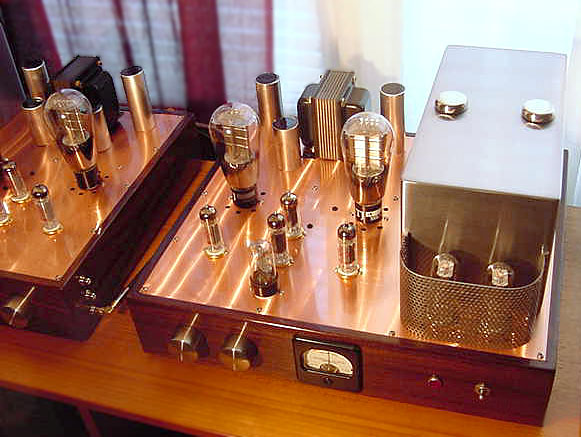
The Aurora: built by Gary Dahl, current sources by Gary Pimm, metalwork by Josh Stippich,
rosewood chassis by Phil Bruckbauer, and circuit design by Lynn Olson.

The Amity, Raven, and Aurora I've been designing loudspeaker systems since 1975, but I didn't move into electronic design until 1996, when I started the Amity project. I'd been reviewing various amplifiers for Positive Feedback magazine since 1991, and was intrigued by the whole SE-DHT phenomenon - writing the first US review of the Ongaku left an impression as well.
by Lynn Olson
I auditioned many SE-DHT amplifiers after that, but in all honesty, none came up to the mark set by the Ongaku, although some came pretty close. I met the designer of the Ongaku a couple of years later at the CES, and Kondo confirmed my impression that the circuit of the Ongaku wasn't anything remarkable. It was the implementation - the all-silver signal path, especially the hand-made silver coupling cap and the all-silver output transformer, that gave the Ongaku its distinctive clarity and insight. Kondo-san said that building one on the cheap would just result in a quite ordinary SE amplifier - the Ongaku could be thought of as the ultimate parts-tweaker amplifier, a design that would sound completely different if all parts weren't exactly as specified.
Anyone that listens to SE amplifiers over any length of time is going to become aware just how different they sound from each other. Transistor amplifiers, at least if competently designed, sound more or less alike. Vacuum tube amps that replicate the design philosophy of the Fifties (Class AB PP pentode, quasi-Williamson, 20dB of loop feedback) also have a characteristic "group sound" - and of course different than transistor amps. These two classes of amps are what most audiophiles the world over had heard until the re-introduction of SE-DHT amps in the early Nineties, which created turmoil and dissension in the industry and trade magazines that lasts to this day.
Joe Robert's Sound Practices magazine promoted the combination of (very) low power, direct-heated triodes, single-ended circuits, and efficient speakers. By the mid-Nineties, SE-DHT almost became a religious cult, diverging rapidly away from the mainstream universe of hyper-expensive, super-power amps, low-efficiency speakers, with the whole industry driven by reviews in the Big Two magazines. Politics combined with a technological package, in other words.
As reviewer of the Ongaku (and designer of the 92dB efficient Ariel) I was drawn into the SE-DHT debate as well - but I never bought the religious angle. I agreed more speaker efficiency was a Good Thing, but didn't care for horn coloration (and still don't). The superiority of direct-heated triodes, by measurement and audition, is clear-cut, but there are design challenges related to filament power (and isolation) and serious demands on the driver stage - as well as coming to terms with the modest power, fragility, and considerable cost of direct-heated triodes.
Where I parted company with the SE-DHT crowd was single-ended circuits; for the output stage, at least, there are drawbacks to SE circuits compared to Class A PP (Class AB PP is another matter, and sonically is the worst of all). But a little research disclosed that PP amplifier design had essentially stagnated since the mid-Fifties; in fact, there was a period between the introduction of the Williamson in 1948 and the mid-Fifties when there were essentially no new designs at all!
More surprisingly, the mainstream high-end industry was just endlessly recycling trivial variations of Fifties designs over the last thirty years. Almost all products in the mainstream high-end market used the same stale tubes - 12AX7, 12AU7, 12AT7, 6DJ8, EL84, EL34, KT88 - and the same stale circuits - Williamson, Dynaco, Acrosound, or Marantz derivatives (which are all very similar). No wonder SE-DHT was making a stir - it was thirty years overdue!
By contrast with the US market, the Japanese had a wild variety of tubes and circuits, and had been playing with them since at least the early Seventies. SE, PP, OTL, hybrid, exotic ultra-rare tubes, specialized radio-transmitter tubes, circuits that ran in positive-grid bias, transformer coupling, anything you could imagine. In addition to the fun articles in MJ magazine, I'd been been reading Norman Crowhurst articles for many years, and I wanted to try a circuit that had the lowest possible intrinsic distortion, especially into typical speaker loads.
As a loudspeaker designer, I knew all too well that expecting speakers to be resistive was a vain hope - in fact, the best speakers are typically the most reactive and hardest to drive! I wasn't willing to cherry-pick speakers that were "SE-friendly" - to me, that's another way of saying "speaker-unfriendly." Speakers, by their nature as electromechanical transducers, are not just reactive, but store resonant energy for tens of milliseconds and transmit it back to the amplifier - and all speakers do that, electrostatic, planar, horn, single or multiple-driver. Speaker drivers are intrinsically resonant.
Thinking along these lines - an amplifier that remains linear when driving a complex, nonlinear, and poorly-defined load - leads to Class A PP, preferably with direct-heated triodes instead of triode-connected pentodes. (Tests in Vacuum Tube Valley magazine shows DHTs have about one-half to one-third the distortion of triode-connected pentodes, not a small difference.) The reason is clear when you look at the composite curves of Class A PP triodes: the grid-lines are essentially straight and parallel, so when the load-line opens into an ellipse (becomes reactive) there is no change in distortion.
BY contrast, all other other circuits and devices ... SE, or PP with Class AB, or pentodes, transistors, MOSFETs, etc. all have grid-lines that are curved. Class AB pentode (or transistor) is the worst, with high curvatures centered around the zero-signal region. In others words, the first watt is the worst watt ... but it only appears with reactive loads! Unfortunately, speakers are reactive: they can't help it, they're bandpass filters, and they also store energy for relatively long periods of time (milliseconds) and reflect it back to the amplifier. With most amplifiers, the reactive and delayed energy from the speaker driver greatly increases the amplifier distortion. This is why amplifiers can sound so different with different speakers.
With SE, the overall curvature of the grid-lines is still there, but is quite mild in the zero-signal region; the first watt really is the best watt. This is a critical point; music spends most of the time at low levels, with brief peaks that jump to 10 to 14 dB above the average. On a statistical basis, the greatest percentage of the time is in the 1-watt or lower region, at least if the speaker has any kind of reasonable efficiency.
But ... if you want linearity at low and high levels, near-total immunity from reactive loads, only PP triodes operating in very deep Class A can deliver straight and nearly parallel grid lines. The very deep Class A operating point keeps the circuit well away from the undesirable Class AB region; this is only entered when the load becomes a near-short, one that would current-limit and clip a SE amplifier.
Another goal is getting driver-stage coloration and distortion out of the picture ... quite different from the distortion-cancellation technique seen in some SE amps. I've never felt good about dissimilar devices maintaining cancellation over a wide range of signal levels and frequencies, and most of all I wanted an amplifier with a stable harmonic signature. Since I worked with cancellation techniques back when I patented the Shadow Vector Quadraphonic Decoder in 1975, I was all too aware that the "gotcha" of any subtractive techniques is the dirty nature of the residual, which calls attention to itself if the "dirt" changes character with different types of music.
I am beginning to suspect the ear compensates for amplifier distortion if it is simple in nature and stable (which is another reason for the excellent subjective quality of SE circuits), but does not like distortion that is constantly changing. Unfortunately, conventional phase-splitters have asymmetric output impedances, an asymmetric Miller capacitance, or sensitivity to B+ voltage, so the cancellation of the even-harmonic distortion terms (2nd, 4th, etc.) bounces up and down with the program material. The instability of the distortion characteristic is very likely the source of the usual PP "fog" and vagueness compared to the more direct and immediate SE sound.
To solve this problem, we need to go all the way back to classic Thirties-style interstage-transformer coupling. For the lowest distortion, the drivers need to have essentially horizontal load-lines, i.e. a very high impedance load relative to the plate impedance ... preferably more than ten times higher.
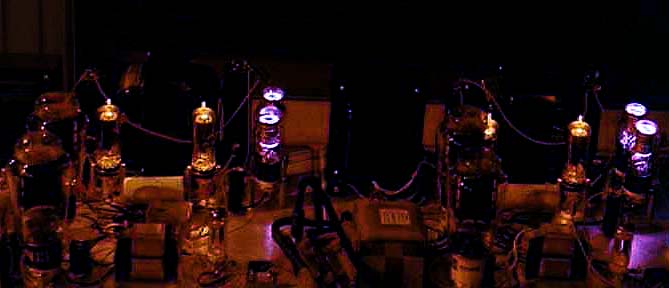
The only way to accomplish this is some kind of dynamic load ... and the extra B+ headroom that requires ... or choke or transformer loading. Since I also wanted highly symmetric phase splitting that was invariant with signal level, I chose the interstage-transformer, and sought out the classic UTC and Sakuma amps for inspiration. My personal esthetic favors wide bandwidth, so the Lundahl transformers presented themselves as high-quality choices. In the PP world, high-frequency balance is more rare than you would expect; many expensive transformers have asymmetries in the capacitive balance, and this has a disastrous effect on HF distortion. It doesn't do any good to have precision-balanced tubes if the transformer itself is out of balance.
Another difference between this amplifier and the "classics" is of course much wider bandwidth than the "old days" in the Thirties when these circuits were last used. Back then, no wideband sources were available (with the exception of Major Armstrong's Yankee FM network). Everything else was both narrowband and noisy: intercity AM network radio (carried by Bell System land-lines), shellac 78rpm records, and optical sound-tracks for movies. Modern expectations for 65 to 100dB S/N ratios and 20Hz to 20kHz bandwidth simply didn't exist. Recycling antique parts and antique circuits will, of course, deliver vintage sound. That wasn't my goal. I wanted the unmatched linearity of triodes and transformer coupling, combined with modern bandwidths of 15Hz to 50kHz.
This is where modern transformers and carefully selecting low-plate-resistance tubes makes a difference. Transformer bandwidth is improved by having a low impedance on the primary, secondary, or both. One reason that interstage transformers are harder to design than a conventional output transformer is that impedance on both primary and secondary is high, while for the output transformer at least the secondary is low. Since the secondary is ideally unloaded in an interstage application (this gives the lowest distortion for a triode), the only good way to get satisfactory bandwidth from the interstage transformer is select a driver tube that has a low plate impedance.
Tubes that fit this application are the 5687/7044/7119 family or the Russian 6H30. (Although the familiar 6DJ8/6922/E88CC has low plate impedances, it also has moderately high third-harmonic distortion and limited output swing, which make it inappropriate for a PP DHT-triode amplifier.)
Moving on to the main B+ supply, I first tried a 5R4-GY rectifier (a traditional choice for 300B circuits), but was dismayed with the arc-overs and poor reliability in several examples. Maybe they were old and weak, but this sort of failure should never happen in the first place. By contrast, TV damper diodes, including the New-Old-Stock 6C*3 family and the new Svetlana 6D22S, have more-than-ample peak curves, and derating for continuous use gives more headroom in current and voltage than the traditional tube rectifiers seen in 2A3 or 300B amps. The low voltage drop (15V), huge peak currents (2A), and slow warm-ups (30 seconds) are just additional bonuses.
Matt Kamna also demonstrated a technique for zooming in on the waveform on the power-transformer secondary (about 10V/div on the scope screen). The rough appearance around the zero-crossing was very obvious with solid-state diodes. HEXFRED's gave a small improvement, but conventional tube rectifiers looked much smoother, and the TV damper diodes were by far the smoothest of all. So even in low-current preamp applications, TV damper diodes give the least noise. I know from experience in the Tektronix Spectrum Analyzer division that it's much easier to eliminate noise at the source than filter it afterward. If there was an even quieter device, I'd use that, but as far as I know, TV damper diodes are the quietest from the viewpoint of switching noise. Considering that the main B+ supply is switching five hundred volts, this is not a small consideration, since switch-noise is radiated in all directions, into the B+ supply, the interior of the chassis, and back into the power cord.
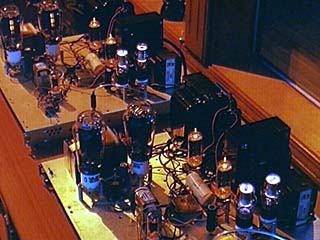
A deluxe feature, which was easy to add, is the Voltage Regulator (VR) tube shunt-regulation for the driver. I wanted to drop 270 volts, so why not regulate at the same time? The noise of VR tubes is only 1mV of very smooth broadband noise, while the more common Zener diodes have 3 to 5mV of spectrally nonflat noise, occasional LF bumps and pops from "popcorn" noise, problems with temperature coefficients, and a huge amount of grossly nonlinear capacitance. Zener diodes need a lot of filtering and additional circuitry to isolate the problems. By contrast, VR tubes need no additional circuitry at all - just keep them away from capacitive loads.
Not only are old-timey VR tubes quiet, they're nice to look at. The purple glow of the OC3's is an subtle "ON" indicator. When the VR's light up after the lengthy 30 sec warmup from the damper diodes, you know the amp is well and truly running.
The original 1997 Amity used the simplest isolation between the VR tube and the main B+ possible; a pair of 2K 20-watt power resistors in series with a 100 uF filter cap between them. This simple RC filter worked well and was essentially unbreakable. The latest version, shown when you click the diagram, features current sources for better isolation between driver and output stage. Either version works well; the choice is yours.
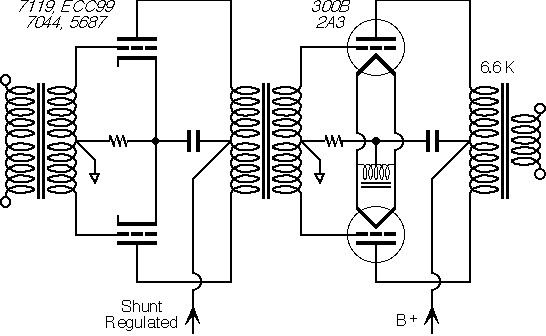
Click for full schematic diagram
Although the Amity is a beautifully simple design, it makes severe demands on the preamp. The preamp has to drive the combined capacitance of the interconnect cable, the input transformer, and the Miller capacitance of the input tubes. This can easily add up to 200 to 600pF of capacitance, depending on how long your cables are and if you choose to use a 1:2 step-up in the input transformer (which quadruples the 60pF Miller capacitance of the input tubes). In all honesty, this is difficult load for most tube preamps, with 12AX7 cathode-follower preamps falling down the worst. (1mA cannot drive 600pF!) Preamps with 12AU7 cathode-followers aren't much better, sounding very "tubey," rolled-off, and old-fashioned.
(Passive preamps cannot be used with the Amity since the input transformer must be driven with less than 600 ohms source impedance. A passive preamp using a 10K pot presents 2.5K source impedance to the power amp in the -6dB position, which will cause a significant decrease in transformer bandwidth. No harm to the Amity will result, just degraded sound quality.)
I borrowed many different preamps, bought some of them too, sold them at a loss, and just about the only one that sounded decent was a borrowed Jeff Rowland Consonance preamp. The A/B test was simple: I had a very high-quality DAC using the Burr-Brown PCM-63K converters, and I would compare a direct connection to the Amity versus a preamp. A preamp compared to a piece of wire - awkward on many CD's since the only volume setting was full up (no passive volume control allowed, remember). Still, it was obvious that most preamps added odd-sounding electronic colorations, as well as more serious deficits that flattened or removed qualities of air, space, musical textures, and an intangible quality that I call vitality, or immediacy. Most tube preamps, in fact, were downright dull and flat-sounding.
The Amity is transparent enough that with most preamps, you could never hear the Amity - just the preamp, mimicking the colorations of a lesser-quality power amp. When the preamp was removed, though, the truth was out - it was the preamp, not the power amp, that was adding the amp-like colorations.
A pretty disappointing state of affairs, and I didn't want to mindlessly copy the Jeff Rowland, although I appreciated the elegance (and boldness) of transformer-coupling a high-speed opamp in a preamp, thus keeping the solid-state electronics happy by filtering off ultrasonics from the CD source. So it was time to try my hand at designing a linestage preamp. I dreamed up the original Raven concept some time around 1998 - click the picture for the full schematic.
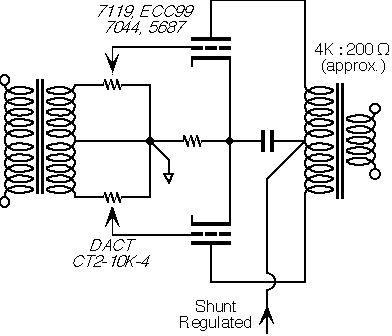
Click for full schematic diagram
(Historical footnote: The Raven is basically a Western Electric line-driver with modern components and shunt regulation. By the way, did you know the audio-engineering phrase "line-driver" dates back to Bell System telephone line repeater amplifiers which pushed the voice signal down another twenty miles of twisted-pair wire? Remember, no coax, RF modulation, or digital conversion back in the Twenties and early Thirties, just carefully-balanced voice circuits with repeaters and phase-correction networks. The NBC and CBS radio networks leased Bell System broadcast-grade intercity links for coast-to-coast broadcasts - dedicated sets of twisted-pair wires that were set aside for radio use only, with top-quality 50 Hz to 8 kHz bandwidth and special precautions to minimize noise over the many repeaters and hundreds, or thousands, of miles of wire carried on telephone poles.)
Interestingly enough, even though exotic audiophile preamps cost $7500 or more, when you look at the schematic, you'll almost always see a capacitor-coupled design, typically a cap-coupled cathode-follower with an active current-source pulldown. Transformer coupling is still quite rare in the vacuum-tube world, yet it has so many advantages in terms of breaking system ground loops and a powerful, high-current drive capability. You can parallel all the tubes you want, and you still won't have the current capability - and very low distortion - of a transformer-coupled design.
But I'm getting ahead of the story. Back in 2001, freshly arrived in Silverdale, and setting up Nutshell High Fidelity, the problem of the Amity preamp remained. There was a reasonable chance that folks would build or buy the Amity and use it with an average-quality off-the-shelf preamp. I knew from experience that this wouldn't work; the Amity doesn't appreciate most preamps, enough so that it is impossible to hear what the Amity actually sounds like. So I started work on the Aurora, which has its own built-in high-quality linestage.
Gary Dahl and I spent most of the summer of 2002 working on the Aurora. The Aurora is a direct extension of the Amity, with a simple SE preamp stage ahead of the PP driver and output section. Some of the best preamp/input tubes are the real oldies - the 6P5 (octal), the 76 (the same tube with a 5-pin base), and its predecessors - the 56, 37, or the grand-daddy of all indirect-heated triodes, the 27. All of them work fine with the 500-ohm cathode resistor and an operating current of 10mA, although the 27 and 56 require 2.5V AC for the heater instead of the more typical 6.3V AC for the 37, 76, or 6P5.
Since some of these types are also coveted by the vintage radio-restorer community (which is bigger than you might think), some models can be expensive - this corresponds to rarity, not sonics, so avoid paying big money for them. In the USA, at least, the 6P5 or 76 are not that rare. The prices you see in Antique Electronics usually corresponds to the rarity of a tube, so check their latest listing.
(Antique also carries octal, UX4, and five-pin sockets, as well as VR tubes and damper diodes. When you order the damper diodes, make sure you get the matching sockets for the models you order - they do not use conventional nine-pin miniature sockets, and the Russian and NOS tubes use different sockets.)
Don't be preoccupied with New-Old-Stock condition, either - moderately used tubes work just fine, especially in the light duty in this circuit. Avoid metal-can tubes - thanks to internal outgassing from the metal, these sound dreadful, while traditional globe, G, or GT styles sound fine (vintage radio collectors drive up the price of certain styles - remember, they're after appearance, not sonics).
You might think that really old tubes - designs dating from the early Thirties - sound "vintage" and "tubey." Actually, they don't. Tubes in this family (27, 37, 56, 76, and 6P5) actually sound fast, quick, and incisive, and have very low distortion, along with a favorable distribution of harmonics. If you want a traditional mellow "vintage" sound, you're thinking of a 12AU7, the tube used almost universally in late 1950's amplifiers and many guitar amps - with distortion many times higher than the early Thirties tubes.
The universal adoption of feedback in the late Forties allowed electron-tube designers to relax their concerns about distortion and focus on cost, heat emission, and package size instead. Audiophile vacuum-tube amps from the Seventies through today continued with the late-Fifties favorites of the 12AX7 and 12AU7, which are actually considerably worse than the octal predecessors, the 6SL7 and 6SN7.
The really superior tubes of the mid-to-late Fifties and early Sixties, the 5687, 7044, and 7119, were only used in commercial and aerospace applications, never in high-fidelity electronics sold to consumers. At the time, the American electronics industry was divided into two sectors, consumer and commercial/military, and the engineers didn't talk to each other. Putting it less kindly, the good engineers went into the commercial, instrumentation, and military sectors, while the not-so-good engineers went into the high-fidelity business. In the Thirties, the best electronic engineers in the world were designing radio and movie-sound systems, but World War II changed that, pulling the best engineers into the military/aerospace sector - which is still true today in North America and Europe.
It wasn't until the late Nineties that the space-age family (5687, 7044, 7119) and radio-age family (27, 37, 56, 76, 6P5) were re-discovered. It's not the looks, it's the performance. These triodes stand out for their low distortion and favorable distribution of harmonics, lower than any other type of analog device, pentode, bipolar transistor, JFET, or MOSFET. They sound good for a reason.
Another important part of the Aurora is the 2.2uF to 4uF 200V parallel-feed capacitor between the cathodes and the center-tap of the transformer primary. This is a critical part; the sonics of this single capacitor creates the sound of the entire amplifier. Do NOT use generic polypropylene caps in this location - you'll end up with a dull, murky-sounding amplifier. My personal favorites are Teflon caps, although these are astronomically expensive by the time you get to the required value. You can get some of the sonic benefits by using a smaller, higher-quality bypass capacitor, typically 1/10th to 1/20th of the value of the larger cap.
If you've gotten the impression that SE amplifiers are sensitive to parts tuning, you're right. Both the SE input tube and the choice of parallel-feed capacitor have a startling effect on the overall sound of the amplifier - make the wrong choice, and the amp can be either harsh and shrill or dull and muffled.
I never did find out what the Aurora sounds like - it just mimics the sound of the fairly large-value parafeed capacitor. Unfortunately, the best caps are the small ones, like air trimmers and silver-mica (only available with small values in the pF range), along with Teflon (shockingly expensive in larger values). Paper caps have a shortened lifetime when you apply 200V across them (measure the leakage current of old paper caps in vintage TV's and radios). Metallized polypropylenes (even boutique types) should be avoided in favor of high-quality metal-foil polypropylenes, which are probably the best real-world choice.
Capacitor sonics are less of a problem in less transparent (more distorted) amplifiers, but people who build the Amity and Aurora will discover the amplifiers are startlingly transparent and not forgiving of low-quality parts - coupling caps being the worst offenders. For some reason, transformers are better at retaining instrumental color and emotional expressiveness in the playing - while most caps, if not all, erase a lot of the expressiveness, kind of like MP3 digital compression flattening out in the inner detail and sparkle. With many caps in the signal path, this goes unnoticed, but when you get down to the last one, it's a lot more audible.
I don't know why this effect occurs, and many audiophiles don't hear it. I'm also sure most vacuum-tube amp designers in the high-end audio business would disagree with me - otherwise they wouldn't be designing RC-coupled PP-pentode amplifiers similar in style and sonic character to vintage amps of the 1950's.
Designing the Aurora wasn't a completely satisfactory experience. The Amity "dropped into place" in a matter of weeks, but the Aurora, in a sense, was never completed, since one critical part dominated the sound, and I never found a very good solution. Some audiophiles are thrilled to endlessly compare caps, cables, etc. on a few favorite pieces of music, but I'm not one of them. Parts-rolling is not something I enjoy; instead of listening for pleasure, it's listening for faults, and I can say caps have a lot of faults.
After reflecting on this for a while, I looked back at the Amity, and decided I'd gotten it right the first time around. Fully-balanced, no single-ended circuits anywhere, and most important of all, no coupling caps in the signal path. Time to start with a fresh sheet of paper.
The Karna Amplifier
© 2004 Lynn Olson.